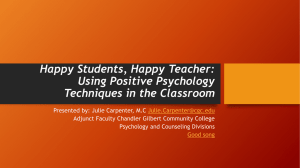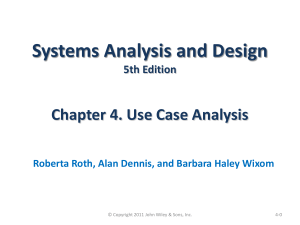Living Psychology by Karen Huffman
advertisement
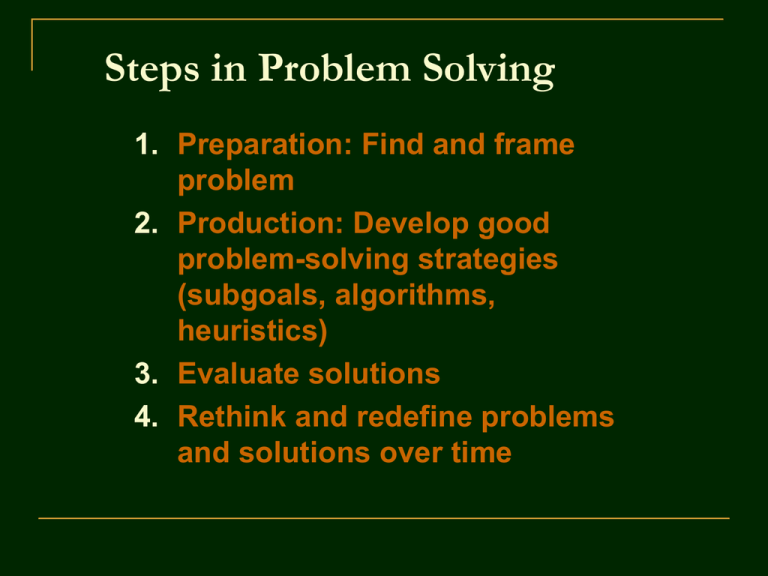
Steps in Problem Solving 1. Preparation: Find and frame problem 2. Production: Develop good problem-solving strategies (subgoals, algorithms, heuristics) 3. Evaluate solutions 4. Rethink and redefine problems and solutions over time Heuristics vs. algorithms Heuristics: general problem solving strategies that are often useful but not always effective (in football: control line of scrimmage, avoid turnovers, in chess: control center of board.) Algorithms: step by step procedures guaranteed to solve a specific problem (recipe to bake a cake, formula to solve for area of triangle) ©John Wiley & Sons, Inc. 2007 Huffman: Psychology in Action (8e) Examples of Heuristics 1. Means-end analysis: breaking problem down into series of sub-problems. 2. Analogies: using past experience as model for current problem-solving Research on use of analogies (past experience) contradictory. fixation - using a prior strategy only functional fixedness - fixated on usual functions ©John Wiley & Sons, Inc. 2007 Huffman: Psychology in Action (8e) When is past experience harmful? Dunker (1945) Make a lamp problem. ©John Wiley & Sons, Inc. 2007 Huffman: Psychology in Action (8e) Thinking—Five Key Barriers to Problem Solving 2. Functional Fixedness: thinking of an object as only functioning in its usual way Can you use these supplies to mount the candle on the wall so that it can be lit in a normal way without toppling over? ©John Wiley & Sons, Inc. 2007 Huffman: Psychology in Action (8e) Thinking—Five Key Barriers to Problem Solving (Functional Fixedness Continued) To overcome functional fixedness, think of the matchbox, tacks, and candle all functioning in new ways. ©John Wiley & Sons, Inc. 2007 Huffman: Psychology in Action (8e) When is past experience harmful? Mental set: retaining a old successful problem-solving procedure even though it is not effective in its current context. Water jar example here! ©John Wiley & Sons, Inc. 2007 Huffman: Psychology in Action (8e) Experimental testing for mental set: Luchin’s (1942) water jar problem: ©John Wiley & Sons, Inc. 2007 Huffman: Psychology in Action (8e) Thinking—Five Key Barriers to Problem Solving 1. Mental Set: persistence in using strategies that have worked in the past Using no more than four lines, can you connect all nine dots without lifting your pencil from the paper? ©John Wiley & Sons, Inc. 2007 Huffman: Psychology in Action (8e) Thinking—Five Key Barriers to Problem Solving (Mental Sets Continued) To overcome a mental set you must “think outside the box”— literally! ©John Wiley & Sons, Inc. 2007 Huffman: Psychology in Action (8e) When is past experience helpful to problem solving? 1. Gick & Holyoak (1980) studies of problems solving with and without past experience 2. Chi’s (1985) studies of expertise and problem solving ©John Wiley & Sons, Inc. 2007 Huffman: Psychology in Action (8e) Problem solving in Physics professors vs. students: Problem categorization ©John Wiley & Sons, Inc. 2007 Huffman: Psychology in Action (8e) Problem solving in Physics professors vs. students: Problem categorization ©John Wiley & Sons, Inc. 2007 Huffman: Psychology in Action (8e) Problem solving in Physics professors vs. students: Problem categorization ©John Wiley & Sons, Inc. 2007 Huffman: Psychology in Action (8e) Framing Effects in Problem solving Imagine that the U.S. is preparing for the outbreak of an unusual… disease which is expected to kill 600 people. Two alternative programs have been proposed. Assume that the exact scientific estimate of the consequences of the program is as follows: If Program A is adopted, 200 people will be saved. If Program B is adopted, there is a 1/3 probability that 600 people will be saved and a 2/3 probability that no people will be saved. Which of the two programs would you favor? Imagine the identical situation with the following choices: If program C is adopted, 400 people will die. If program D is adopted, there is a 1/3 probability that nobody will die, and a 2/3 probability that 600 people will die. Which of the two programs would you favor? ©John Wiley & Sons, Inc. 2007 Huffman: Psychology in Action (8e) Decision-Making Biases Confirmation Bias search only for info that supports our ideas Hindsight Bias report falsely that we predicted an outcome Availability Heuristic predict probability based on ease of recall Base-Rate Fallacy ignore info about general principles Representativeness Heuristic make judgments based on stereotypes Reasoning mental activity of transforming information to reach conclusions inductive reasoning - driven by data; bottom-up; specific general deductive reasoning driven by logic; top-down; general specific Syllogistic reasoning: premises – conclusion Conditional reasoning: if-then statements used draw conclusions Reasoning Syllogistic reasoning Premise: statement assumed to be true for sake of argument, not necessarily empirically true Premise: All boys are athletes Premise also usually expresses a relationship between certain concepts, so boys are related to athletes in that all boys are a member of the category athletes. ©John Wiley & Sons, Inc. 2007 Huffman: Psychology in Action (8e) Syllogistic reasoning Conclusion: to be valid must be necessitated by the premises. Must be only possible conclusion drawn base on relationships expressed in premises. Conclusion: a valid conclusion cannot just be reasonable or plausible based on premises, it must be necessary. ©John Wiley & Sons, Inc. 2007 Huffman: Psychology in Action (8e) Syllogistic reasoning P1: All boys are athletes P2: All athletes are muscular C: All boys are muscular Valid: Use Venn Diagrams to determine. ©John Wiley & Sons, Inc. 2007 Huffman: Psychology in Action (8e) Syllogistic reasoning P1: All boys are athletes P2: All muscular people are athletes C: All boys are muscular people Valid? See website for more reasoning problems ©John Wiley & Sons, Inc. 2007 Huffman: Psychology in Action (8e) Conditional reasoning If: antecedent condition Then: consequent When the antecedent condition is met, the consequent will occur (no question about it!) Observation – what condition is actually present Conclusion: (valid or not valid) ©John Wiley & Sons, Inc. 2007 Huffman: Psychology in Action (8e) Conditional reasoning If she has red hair Then she buys new shoes Observation: she has red hair (affirming antecedent) Conclusion: she buys new shoes (valid?) ©John Wiley & Sons, Inc. 2007 Huffman: Psychology in Action (8e) If she has red hair Then she buys new shoes Observation: she has not red hair (denying the antecedent) Conclusion: she buys not new shoes (valid?) ©John Wiley & Sons, Inc. 2007 Huffman: Psychology in Action (8e) If she has red hair Then she buys new shoes Observation: she buys new shoes (affirming the consequent) Conclusion: she has red hair (valid?) More conditional reasoning problems at my website. ©John Wiley & Sons, Inc. 2007 Huffman: Psychology in Action (8e) If she has red hair Then she buys new shoes Observation: she buys not new shoes (denying the consequent) Conclusion: she has not red hair (valid) ©John Wiley & Sons, Inc. 2007 Huffman: Psychology in Action (8e) Wason Selection Task Rule: if there is vowel on one side then there is an even number on the other side of the card ©John Wiley & Sons, Inc. 2007 Huffman: Psychology in Action (8e) Abstract reasoning vs. Social contracts reasoning ©John Wiley & Sons, Inc. 2007 Huffman: Psychology in Action (8e) Social contracts version of Wason Selection task ©John Wiley & Sons, Inc. 2007 Huffman: Psychology in Action (8e) Language What is language: a symbolic rule-based system of communication shared by a community Question: can one person have language? ©John Wiley & Sons, Inc. 2007 Huffman: Psychology in Action (8e) Structure of Language Phonology - basic phonemes (sounds) Phoneme :smallest unit of speech or sound Morphology - rules for word formation Morpheme: smallest meaningful unit of language Syntax - rules for combining words to form phrases and sentences Semantics - meaning of words and sentences Pragmatics - use of language Note: Grammar includes all these Properties of language 1. Arbitrariness: fundamental units of language have arbitrary relationship to what they represent e.g. dog = 2. Generativity = from a set of finite fundamental units, infinite meaning is possible 3. Generational transmission: passed on from one generation to the next ©John Wiley & Sons, Inc. 2007 Huffman: Psychology in Action (8e) Properties of language 4. Displacement: can communicate about ideas not in here and now 5. Semanticity: meaningfulness drives all communication ©John Wiley & Sons, Inc. 2007 Huffman: Psychology in Action (8e) Studies in Animal Language A number of species have been studies: dolphins, parrots, whales, etc Most studies have involved nonhuman apes: Chimpanzees, Gorillas, Bonobos Why: close relatives of humans, big brains, highly social ©John Wiley & Sons, Inc. 2007 Huffman: Psychology in Action (8e) History of Ape language studies Cross-fostering: raising an ape as a human baby 1950’s Keith and Cathy Hayes: Viki project, teaching a chimpanzee to speak. Big disaster. Beatrix and Alan Gardner: Washoe project, teaching an ape sign language ©John Wiley & Sons, Inc. 2007 Huffman: Psychology in Action (8e) History of Ape language studies Francine Patterson and Koko: A gorilla learns sign language Herb Terrace and Nim Chimpsky ©John Wiley & Sons, Inc. 2007 Huffman: Psychology in Action (8e) History of Ape language studies Sue Savage-Rumbaugh and the bonobo Kanzi ©John Wiley & Sons, Inc. 2007 Huffman: Psychology in Action (8e) What do apes know about language? Some elementary syntax Some evidence of displacement 100-200 word vocabulary Use is primarily utilitarian, not for sharing experience; 90% of Kanzi’s utterances are requests/commands About at level 2.5 child ©John Wiley & Sons, Inc. 2007 Huffman: Psychology in Action (8e) Language Development Prelinguistic Stage: crying, cooing, and babbling Linguistic Stage: singleutterances, telegraphic speech, and learning the rules of grammar ©John Wiley & Sons, Inc. 2007 Huffman: Psychology in Action (8e) Theories of Language Development – Nature Perspective: language is an inborn capacity that develops primarily by maturation Chomsky’s language acquisition device (LAD) Nurture Perspective: language develops from a complex system of rewards, punishments, and imitation ©John Wiley & Sons, Inc. 2007 Huffman: Psychology in Action (8e)
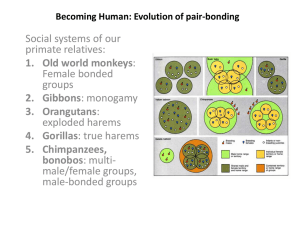


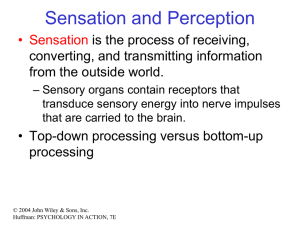

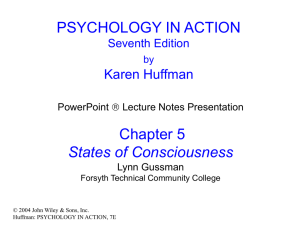



![*************(***N*********** *************Y***Z***[***\***]***^***_](http://s2.studylib.net/store/data/005482918_1-36d5d9818c4ae32819926de4e4a5adce-300x300.png)


